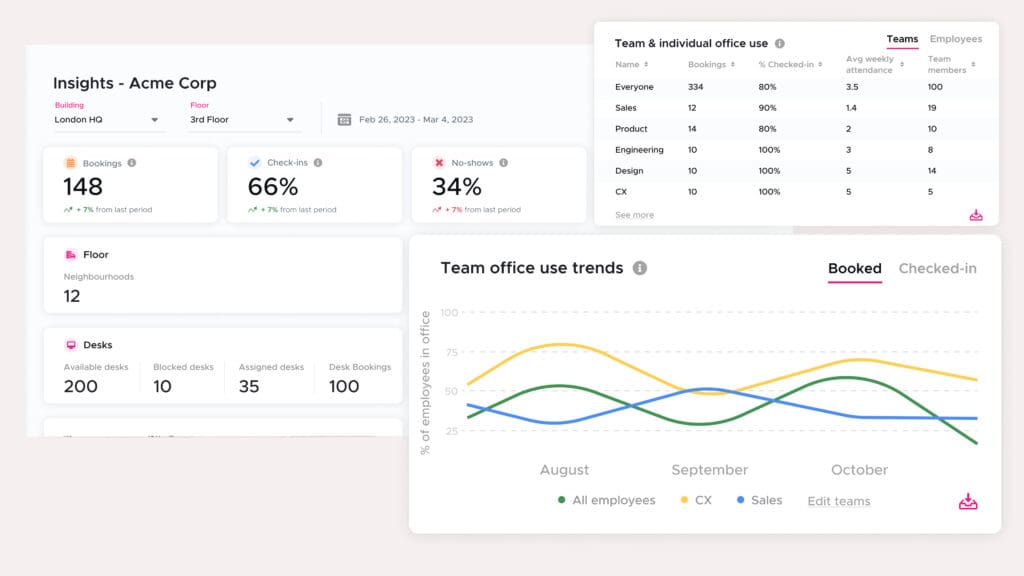Many companies and employees have seen the benefits of working from home. Since the pandemic, many businesses now offer employees the chance to work remotely or with a hybrid combination of some days in office and some days at home. Both remote and hybrid work present unique benefits and challenges. Choosing the right one can significantly impact productivity, employee satisfaction, and overall organizational success.
In this article, we will explore the differences between remote and hybrid work, weighing the pros and cons of each. Ultimately, we’ll demonstrate why hybrid work stands out as the superior model.
Understanding Remote Work
Remote work allows employees to work from any location, typically their homes. This model has gained immense popularity due to advancements in technology, making it easier to collaborate and communicate virtually.
Benefits of Remote Work
- Flexibility and Autonomy: Remote work offers unparalleled flexibility. Employees can create schedules that align with their personal lives, enhancing work-life balance and job satisfaction.
- Cost Savings: Both employees and employers benefit financially. Employees save on commuting costs and time, while employers can reduce expenses related to office space and utilities.
- Access to a Global Talent Pool: Companies are not limited by geography when hiring. They can tap into a diverse pool of talent from around the world, fostering innovation and diverse perspectives.
- Environmental Benefits: Reduced commuting leads to lower carbon emissions, contributing to environmental sustainability.
Drawbacks of Remote Work:
- Isolation and Loneliness: Working remotely can lead to feelings of isolation. The lack of face-to-face interactions can make employees feel disconnected from their colleagues and the company culture.
- Communication Challenges: Without in-person interactions, communication can suffer. Misunderstandings and delays in information sharing are more likely.
- Work-Life Boundaries: The line between work and personal life can blur, leading to overwork and burnout. It’s challenging to switch off from work when your home is your office.
- Limited Access to Resources: Not all employees have a conducive work environment at home. Issues such as inadequate internet connection, lack of proper office equipment, and household distractions can hinder productivity.
Understanding Hybrid Work
Hybrid work combines the benefits of remote work with the advantages of in-office work. Employees have the flexibility to work from home on some days and come into the office on others. This model aims to offer the best of both worlds.
Benefits of Hybrid Work:
- Balanced Flexibility: Hybrid work provides a mix of flexibility and structure. Employees can enjoy the convenience of remote work while benefiting from regular in-person interactions.
- Enhanced Collaboration: In-office days facilitate better communication and collaboration. Teams can brainstorm, solve problems, and build relationships more effectively face-to-face.
- Improved Employee Well-being: The combination of remote and office work can mitigate feelings of isolation while still offering the flexibility employees value. This balance can enhance overall well-being and job satisfaction.
- Efficient Resource Use: Hybrid work allows for more efficient use of office space. Companies can downsize their physical offices, reducing overhead costs while still providing a collaborative environment.
Drawbacks of Hybrid Work:
- Complex Scheduling: Coordinating in-office days can be challenging. Ensuring that the right team members are present simultaneously requires careful planning and can be logistically complex.
- Potential Inequities: Hybrid work can create disparities among employees. Those who can come to the office more frequently might have better access to opportunities and resources, leading to potential resentment and inequality.
- Transition Challenges: Shifting to a hybrid model requires a change in organizational culture and processes. Companies need to invest in technology and training to ensure a smooth transition.
The Solution is Kadence
Many of the possible negatives of working hybrid can easily be solved through Kadence. Kadence’s desk booking software makes hybrid easy.
Scheduling does not need to be complex. Booking desks in the office can be completed in a few simple clicks. Kadence’s Smart Suggestions can tell you when your colleagues are coming into the office, so you can book a desk nearby. Managers can set team days where neighborhoods reserve space for team members coming into the office.
With insight and overview of when your teammates are coming into the office, the risk of potential inequalities is mitigated. Employees don’t have to fear missing out if they choose to work from home.
And with Kadence’s simple onboarding process, teams will know how to use Kadence quickly and efficiently. The transition to a seamless hybrid work model can be easy and painless for your company.
Comparing Hybrid and Remote Work
Productivity and Performance
Remote Work: Productivity can increase due to fewer distractions and personalized work environments. However, this heavily depends on individual discipline and effective self-management.
Hybrid Work: The blend of environments can lead to a well-rounded approach to productivity, with structured office days boosting team performance and remote days supporting individual focus.
Employee Engagement and Satisfaction
Remote Work: While remote work can offer higher satisfaction due to flexibility, it might reduce engagement without regular social interactions.
Hybrid Work: Hybrid work can strike a balance, fostering engagement through periodic in-person interactions while maintaining the flexibility that employees value.
Organizational Culture
Remote Work: Building and maintaining a cohesive company culture remotely can be challenging. Virtual team-building activities and regular communication are essential.
Hybrid Work: In-office days can help reinforce the company culture, allowing for organic interactions and stronger relationships.
Cost Implications
Remote Work: Significant savings on office-related expenses, but may require investment in remote working tools and employee stipends for home office setups.
Hybrid Work: Potential for optimized office space usage, with reduced costs for maintaining a physical office and supporting remote work infrastructure.

Why Hybrid Work is Superior
Hybrid work stands out as the superior model for several reasons:
Optimal Balance: Hybrid work offers the best of both worlds, combining the flexibility of remote work with the benefits of in-person collaboration. This balance can lead to higher productivity, better employee engagement, and a stronger organizational culture.
Enhanced Collaboration: Regular in-office days facilitate face-to-face interactions, which are crucial for effective communication, brainstorming, and problem-solving. These interactions can lead to more innovative solutions and stronger team cohesion.
Improved Well-being: The combination of remote and office work can help mitigate the isolation and loneliness often associated with remote work. Employees can enjoy the flexibility of working from home while still benefiting from social interactions with colleagues.
Resource Efficiency: Hybrid work allows for more efficient use of office space and resources. Companies can reduce their physical office footprint, leading to cost savings, while still providing a collaborative environment for employees.
Adaptability: Hybrid work is inherently adaptable. It allows companies to respond more flexibly to changes in the business environment, whether due to a global pandemic, economic shifts, or other unforeseen events. This adaptability can be a significant competitive advantage.
Practical Solutions for Implementing Hybrid Work
To maximize the benefits of hybrid work and address its challenges, consider the following strategies:
Develop Clear Policies: Define expectations and guidelines for in-office and remote work days. Ensure transparency and fairness in scheduling by using Kadence.
Promote Equity: Ensure equal access to opportunities and resources for all employees, regardless of their work location. Address any disparities that may arise. Offer access to co-working spaces that can be used by employees located outside of the local office area. Kadence Flex gives companies access to hundreds of co-working spaces globally.

Encourage Flexibility: Allow employees to adjust their schedules as needed, recognizing the diverse needs and preferences within the workforce. Trust your employees to manage their time effectively.
Foster a Strong Culture: Use in-office days to reinforce company culture. Organize team-building activities and encourage social interactions. Ensure remote employees feel included and valued through regular communication and virtual events.
Hybrid work stands out as the superior choice. It provides the flexibility and autonomy of remote work while enhancing collaboration, engagement, and well-being through regular in-person interactions. By adopting a hybrid work model, organizations can create a balanced, productive, and supportive work environment that empowers employees to thrive in the evolving landscape of work.
Book a demo to find out how Kadence can help you and your company find your rhythm for hybrid work.




